1.800.891.8312
Free Shipping Details
Most orders over $500 qualify. Free shipping applies to Barn Door Hardware, Barn Doors, and Pocket Doors over $500.
Note: Front doors, interior doors, shower doors, any oversized door (wider than 3ft and taller than 7ft) and any special order doors have shipping costs calculated at checkout. Some barn door hardware track lengths do not qualify for free shipping.
Tube Track System Assembly Instructions
Tube Track System Assembly Instructions & Video
Tube Track System Recommended Tools
- Drill with 1/8”, 1/4”, and 3/8” Drill Bits, and Phillips Bit
- 9/16” and 5/8” Combination Wrench
- Socket Wrench With 9/16" and 5/8”
- Level
- Tape Measure
- Pencil
Silhouette Farmhouse Table Parts
- Tube Track
- Lag Screw
- Track Support
- Support with Stop Block
- Floor Mount Door Guide
- Phillips Screw
- Anti-jump Bracket
Tube Track System Assembly Instructions
For Tracks Longer than 8 Feet:
Tracks longer than 8 feet will come with two or more track segments that are joined together by one or more splice bars.
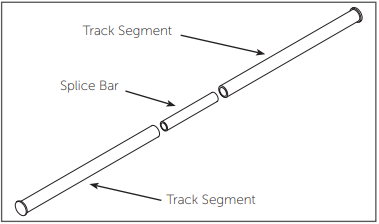
Step 1: Slide the splice bar halfway into a track segment, aligning the hole in the splice bar with the hole in the track segment (Figure 1).

Step 2: Insert the set screw (provided) into the hole in the track segment. Tighten the set screw (Figure 2). Repeat steps 1 and 2 for the other track segment.

Step 3: When installing the tube track, rotate the track so the set screws are facing the wall. For maximum strength, ensure a track support is supporting spliced sections (Figure 3).
 First Things First
First Things FirstCheck to see if the floor below the track area is level. If the floor rises more than 1/2” the door may rub or not slide open completely. If the floor is not level, measure from the highest point of the floor surface to the recommended track placement and adjust track placement accordingly.
Ensure the track will be installed onto wall studs. If wall studs are not lining up with the installation a header will be required to provide the necessary strength and stability for the track and door.
Step 1: To determine where the track should be installed, first measure the height of the door, then add 2-1/4” to the door length. 1/2” will be for the clearance between the bottom edge of the door and the floor. 1-5/8” will be from the top edge of the door to the center of the support. (Figure 1).
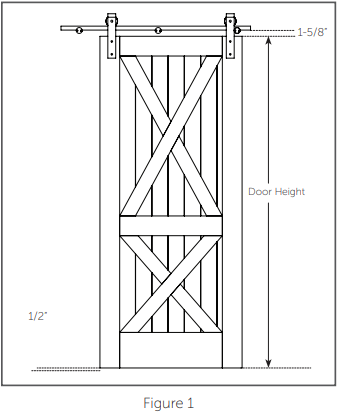
Step 2: Using a level and a pencil, make a line above the doorway the same length as the track.
Step 3: Mark stud locations.
Step 4: Predrill with 1/4” bit.
Step 5: Mount back of tube spacer using lag screw (Figure 2).

Step 6: Attach front of tube spacer, but do not tighten (Figure 3).

Step 7: Lay tube track in groove of spacers and adjust side to side for final placement (Figure 4).
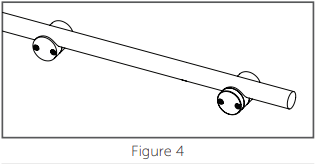
Step 8: Tighten front spacers (Figure 5).

Step 9: Mount door to track (Figure 6).

Step 10: Clamp spacer with stop block to track in desired stopping location. If desired stop location is at a pre-existing spacer, remove screws, add stop block and re-insert screws (Figure 7).

Door Guide Installation
Step 12: With the door in the closed position, ensure the door is hanging straight using a bubble level.
Step 13: Position the Door Guide part way into the groove in the bottom of the door (Figure 7).
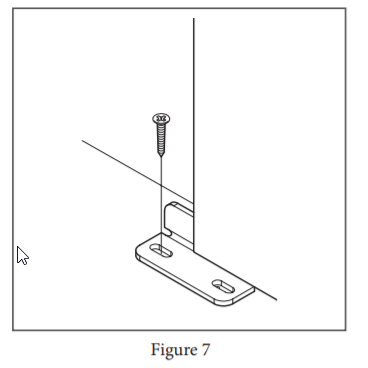
Suggestion: Use double stick tape on the bottom of the door guide to hold the guide in place.
Step 14: Install the Door Guide using a 1” phillips screw (provided) and a drill with a phillips bit.
Step 15: Slide the door toward the open position until the other side of the Door Guide is exposed.
Step 16: Install the second 1” phillips screw (provided) using a drill with a phillips bit (Figure 8).

Anti-Jump Guide Installation
Step 17: Place the Anti-Jump bracket on the door side, moving the bracket up until it is between 1/8” and 1/16” from the bottom edge of the rail. Mark the placement with a pencil.
Suggestion: Use double stick tape on the back of the anti-jump bracket to hold it in place on the door
Step 18: Install the bracket to the door edge with 2 phillips screws (provided) using a drill with a phillips bit (Figure 9).

Step 19: Repeat steps 17 and 18 for the opposite end of the door.
Anti-Jump Block Installation
Step 20: Place the Anti-Jump block on the top of the door (Figure 10). Using a drill with a phllips bit, install the the block with the 1” phillips screw (provided).
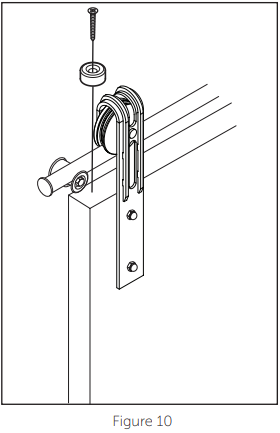
Step 21: Repeat step 20 for the opposite end of the door.
Suggestion: Use double stick tape on the back of the anti-jump block to hold it in place on the door


Hitching Post
Event Venue
1520 N Main Street
Springville UT 84663
PRODUCTS
FEATURES
COMPANY
BUSINESS



